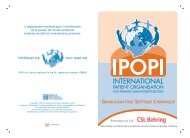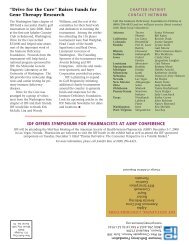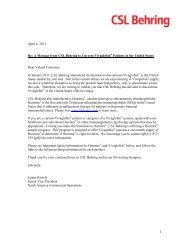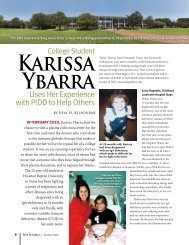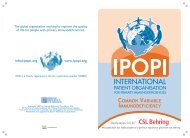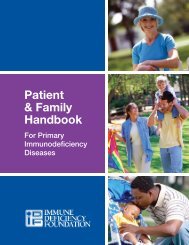Stem Cell Therapy and Gene Therapy
Stem Cell Therapy and Gene Therapy
Stem Cell Therapy and Gene Therapy
Create successful ePaper yourself
Turn your PDF publications into a flip-book with our unique Google optimized e-Paper software.
<strong>Stem</strong> <strong>Cell</strong> <strong>Therapy</strong> <strong>and</strong> <strong>Gene</strong> <strong>Therapy</strong><br />
<strong>Gene</strong> <strong>Therapy</strong><br />
Most primary immunodeficiency diseases are caused by<br />
errors (mutations) in specific genes. It has long been the<br />
hope that one day it would be possible to cure these<br />
diseases by fixing the mutation that causes the disease<br />
<strong>and</strong> thus affect a cure. As a result of the human<br />
genome project <strong>and</strong> similar efforts to map all of the<br />
genes present in human beings, we now know the<br />
identities of the specific genes involved in many<br />
diseases, including the vast majority of primary<br />
immunodeficiency diseases. More genes are being<br />
identified nearly every week. We have finally reached the<br />
stage where that long held hope is becoming a reality.<br />
Not every genetic disorder, including some primary<br />
immunodeficiency diseases, will eventually be<br />
correctable by gene therapy. However primary<br />
immunodeficiency diseases, as a general rule, may be<br />
better suited for this therapy than almost any other class<br />
of genetic disease. Transplantation of HSC taken from a<br />
normal donor has been successful in curing many of<br />
these disorders, so it should theoretically also be<br />
possible to take the patient’s own HSC <strong>and</strong> correct the<br />
genetic defect in those cells by adding a normal copy of<br />
the gene that is causing the disease.<br />
To introduce the gene, we take advantage of the ability<br />
of some viruses (retroviruses) to penetrate into cells <strong>and</strong><br />
to insert their genome into the patient’s own DNA. For<br />
the purpose of gene therapy, viruses have been<br />
modified so that their own genes have been largely<br />
removed <strong>and</strong> replaced with the normal copy of the<br />
defective human gene that is causing the primary<br />
immunodeficiency diseases.<br />
To perform gene therapy, the patient’s HSCs are first<br />
isolated from the bone marrow or from peripheral blood,<br />
<strong>and</strong> they are then cultured in the laboratory with the<br />
virus containing the gene of interest. Various growth<br />
factors are added to the culture to make HSC proliferate<br />
<strong>and</strong> to facilitate infection with the virus. After two to four<br />
days, the cultured cells are washed to remove any free<br />
virus, <strong>and</strong> then they are transfused into the patient. The<br />
cells that have incorporated the gene of interest into<br />
their chromosomes will pass it to all cells that will be<br />
generated when these cells divide. Because the gene<br />
has been inserted into HSC, the normal copy of the<br />
gene will be passed to all blood cell types, but not to<br />
other cells of the body. Because primary<br />
immunodeficiency diseases are caused by gene defects<br />
that affect blood cells, this can be sufficient to cure the<br />
disease.<br />
<strong>Gene</strong> therapy represents a life-saving alternative for<br />
those patients with severe forms of primary<br />
immunodeficiency diseases, who do not have a<br />
matched sibling donor. In these cases, performing an<br />
HSCT from a haploidentical parent or even from a MUD<br />
would carry some significant risks of GVHD. In contrast,<br />
GVHD is not a problem after gene therapy, because in<br />
this case the normal copy of the gene is inserted into<br />
the patient’s own HSC, negating the need for a HSC<br />
donor.<br />
Until now, gene therapy has been used to treat patients<br />
with SCID secondary to adenosine deaminase (ADA)<br />
deficiency, X-linked SCID, CGD <strong>and</strong> WAS. The first<br />
clinical trial of gene therapy was at the National<br />
Institutes of Health in 1990 <strong>and</strong> treated a 4-year-old girl<br />
with ADA deficiency. The design of this first trial did not<br />
attempt to correct the defective HSC, only the T-cells.<br />
This girl is now clinically well <strong>and</strong> still has about 25% of<br />
her circulating T-cells carrying the corrected ADA gene<br />
more than 20 years after her treatment. After this initial<br />
clinical trial demonstrated that gene therapy could be<br />
carried out safely <strong>and</strong> that gene-corrected T-cells could<br />
survive for years <strong>and</strong> function normally, follow up trials<br />
were initiated attempting to cure children with<br />
ADA-SCID by targeting HSC for gene correction. The<br />
results have been spectacular with most of the more<br />
than two dozen ADA-SCID patients attaining a significant<br />
long lasting increase of the T- <strong>and</strong> B-lymphocyte count<br />
IDF Patient & Family H<strong>and</strong>book | 158








